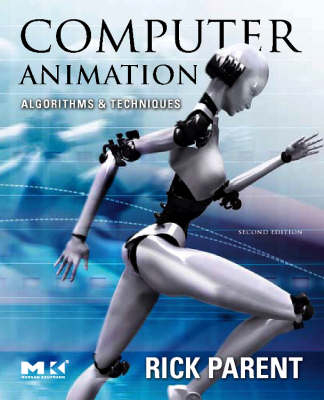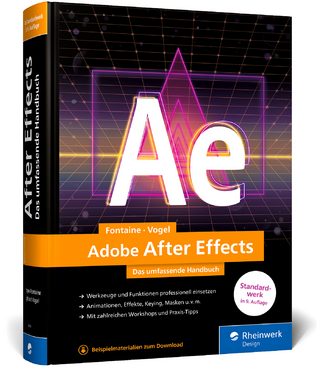
Computer Animation
Morgan Kaufmann Publishers In (Verlag)
978-0-12-532000-9 (ISBN)
- Titel erscheint in neuer Auflage
- Artikel merken
Driven by the demands of research and the entertainment industry, the techniques of animation are pushed to render increasingly complex objects with ever-greater life-like appearance and motion. This rapid progression of knowledge and technique impacts professional developers, as well as students. Developers must maintain their understanding of conceptual foundations, while their animation tools become ever more complex and specialized. The second edition of Rick Parent's Computer Animation is an excellent resource for the designers who must meet this challenge. The first edition established its reputation as the best technically oriented animation text. This new edition focuses on the many recent developments in animation technology, including fluid animation, human figure animation, and soft body animation. The new edition revises and expands coverage of topics such as quaternions, natural phenomenon, facial animation, and inverse kinematics. The book includes up-to-date discussions of Maya scripting and the Maya C++ API, programming on real-time 3D graphics hardware, collision detection, motion capture, and motion capture data processing.
Rick Parent is a Professor Emeritus in the Computer Science and Engineering Department of Ohio State University (OSU). As a graduate student, Rick worked at the Computer Graphics Research Group (CGRG) at OSU under the direction of Charles Csuri. In 1977, he received his Ph.D. from the Computer and Information Science (CIS) Department, majoring in Artificial Intelligence. For the next three years, he worked at CGRG first as a Research Associate, and then as Associate Director. In 1980 he co-founded and was President of The Computer Animation Company. In 1985, he joined the faculty of the CIS Department (now the Department of Computer Science and Engineering, or CSE) at Ohio State. Rick's research interests include various aspects of computer animation with special focus on animation of the human figure.
1. Introduction
1.1 Perception
1.2 The Heritage of Animation
1.3 Animation Production
1.4 Computer Animation Production
1.5 A Brief History of Computer Animation
1.6 Chapter Summary
References
2. Technical Background
2.1 Spaces and Transformations
2.2 Orientation Representation
2.3 Chapter Summary
References
3. Interpolation
3.1 Interpolating Values
3.2 Controlling the Motion of a Point Along a Curve
3.3 Interpolation of Orientations
3.4 Working with Paths
3.5 Chapter Summary
References
4. Interpolation -Based Animation
4.1 Key-Frame Systems
4.2 Animation Languages
4.3 Deforming Objects
4.4 3D Shape Interpolation
4.5 Morphing (2D)
4.6 Chapter Summary
References
5. Kinematic Linkages
5.1 Hierarchical Modeling
5.2 Forward Kinematics
5.3 Inverse Kinematics
5.4 Chapter Summary
References
6. Motion Capture
6.1 Motion Capture Technologies
6.2 Processing the Images
6.3 Camera Calibration
6.4 3D Position Reconstruction
6.5 Fitting to the Skeleton
6.6 Output from Motion Capture Systems
6.7 Manipulating Motion Capture Data
6.8 Chapter Summary
References
7. Physically Based Animation
7.1 Basic Physics - A Review
7.2 Spring Meshes
7.3 Particle Systems
7.4 Rigid Body Simulation
7.5 Enforcing Soft and Hard Constraints
7.6 Chapter Summary
References
8. Fluids: Liquids & Gases
8.1 Specific Fluid Models
8.2 Computational Fluid Dynamics
8.3 Chapter Summary
References
9. Modeling and Animating Human Figures
9.1 Overview of Virtual Human Representation
9.2 Reaching and Grasping
9.3 Walking
9.4 Getting Dressed Up
9.5 Chapter Summary
References
10. Facial Animation
10.1 The Human Face
10.2 Facial Models
10.3 Animating the Face
10.4 Lip-Sync Animation
10.5 Chapter Summary
References
11. Modeling Behavior
11.1 Knowing the Environment
11.2 Aggregate Behavior
11.3 Primitive Behaviors
11.4 Modeling Intelligent Behavior
11.5 Crowd Management
11.6 Chapter Summary
References
12. Special Models for Animation
12.1 Implicit Surfaces
12.2 Plants
12.3 Subdivision Surfaces
12.4 Chapter Summary
References
App A. Rendering Issues
A.1 Double Buffering
A.2 Compositing
A.3 Displaying Moving Objects: Motion Blur
A.4 Drop Shadows
A.5 Billboarding and Impostors
A.6 Summary
References
App B. Background Information and Techniques
B.1 Vectors and Matrices
B.2 Geometric Computations
B.3 Transformations
B.4 Denevit and Hartenberg Representation for Linked Appendages
B.5 Interpolating and Approximating Curves
B.6 Randomness
B.7 Physics Primer
B.8 Numerical Integration Techniques
B.9 Standards for Moving Pictures
B.10 Camera Calibration
References
| Erscheint lt. Verlag | 1.11.2007 |
|---|---|
| Reihe/Serie | The Morgan Kaufmann Series in Computer Graphics and Geometric Modeling |
| Verlagsort | San Francisco |
| Sprache | englisch |
| Maße | 191 x 235 mm |
| Gewicht | 1250 g |
| Themenwelt | Informatik ► Grafik / Design ► Film- / Video-Bearbeitung |
| ISBN-10 | 0-12-532000-0 / 0125320000 |
| ISBN-13 | 978-0-12-532000-9 / 9780125320009 |
| Zustand | Neuware |
| Informationen gemäß Produktsicherheitsverordnung (GPSR) | |
| Haben Sie eine Frage zum Produkt? |
aus dem Bereich



